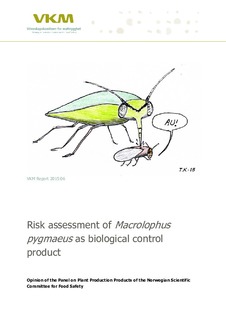Risk assessment of Macrolophus pygmaeus as biological control product. Opinion of the Panel on Plant Production Products of the Norwegian Scientific Committee for Food Safety
Källqvist, Torsten; Sæthre, May; Borgå, Katrine; Dirven, Hubert; Eklo, Ole Martin; Grung, Merete; Lyche, Jan Ludvig; Låg, Marit; Nilsen, Asbjørn Magne; Sverdrup, Line Emilie
Research report
Published version
Permanent lenke
http://hdl.handle.net/11250/2463061Utgivelsesdato
2015Metadata
Vis full innførselSamlinger
Sammendrag
Several commercial products, i.e. Macrolophus-System, Macrolophus-N-System and Macroline c, containing mirids as the active organism(s) belonging to the genus Macrolophus (Insecta: Hemiptera: Heteroptera: Miridae), are registered in Norway. The area of application of these agents are for control of whiteflies in ornamentals, vegetables, spices, fruits and berries cultivated in greenhouses, tunnels and open fields. The current approval of these products was given in 2008. The active organism was at the time identified as Macrolophus caliginosus (syn. M. melanotoma), but recent clarification of the taxonomy has revealed that the correct identity is Macrolophus pygmaeus. The name has been changed accordingly in EPPO’s List of Biological Control Agents widely used in the EPPO region.
The Norwegian Food Safety Authority (NFSA) has received applications to maintain the registration for the products with the revised species name Macrolophus pygmaeus. NFSA has requested VKM’s Panel for plant protection products for their opinion on the consequences of the new knowledge with respect to the active species in the products, as well as an assessment of risks to human health and the environment.
Macrolophus caliginosus does not occur naturally in Norway, and a previous environmental risk assessment concluded that M. caliginosus represented a low environmental risk, due to a very low probability that this species could establish in Norway. Macrolophus pygmaeus on the other hand, is already established in Norway. VKM considers that dispersal/migration of M. pygmaeus into the surrounding environment when used for biological control in greenhouses, tunnels and open fields is very likely, and that such escapes (animals) are likely to become established in the environment. However, since the species is already present in Norway, VKM considers the probability for significant non-target environmental effects from commercial use and distribution of M. pygmaeus to be low.
Regarding possible human health effects, VKM recognises that the species of Macrolophus previously available in commercial products in Norway and Europe has probably always been M. pygmaeus and, consequently, experience and documentation referring to commercial use of M. caliginosus should be considered valid for M. pygmaeus.
The opinion of VKM is that the previous misidentification of the active species of Macrolophus does not have any implication on the health hazard of the products, as was concluded in 2007. Consequently VKM considers that the specified use of M. pygmaeus will involve a minimal health risk for users.
